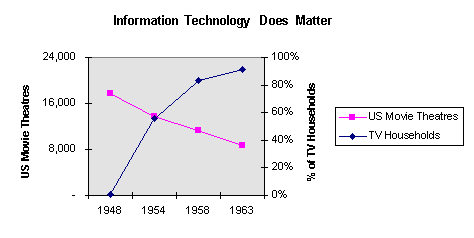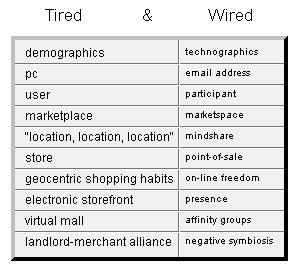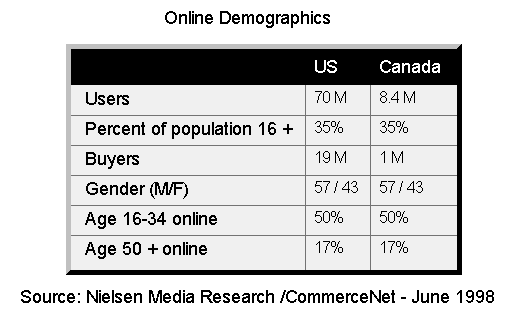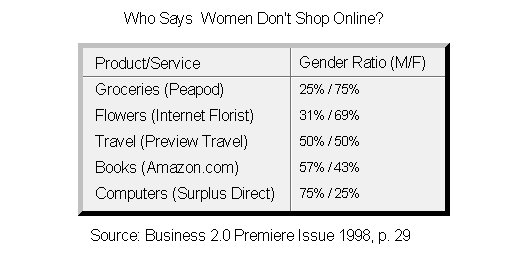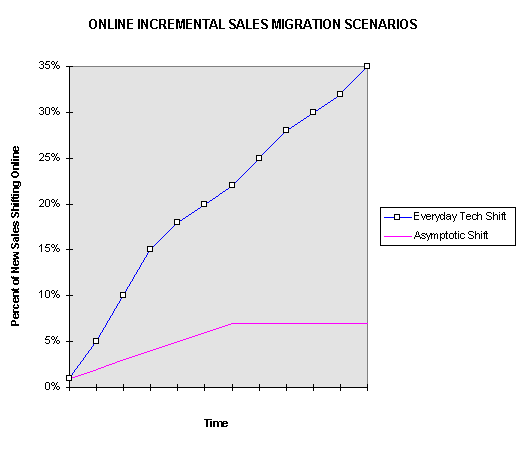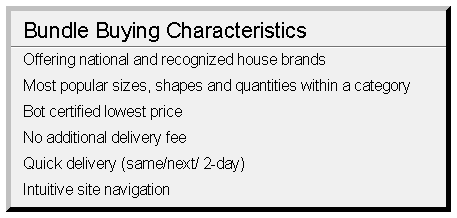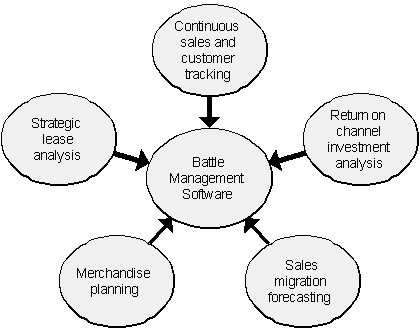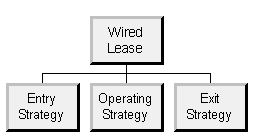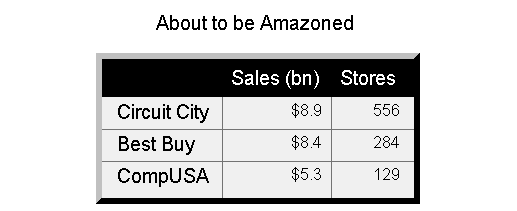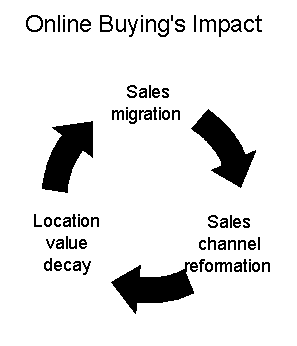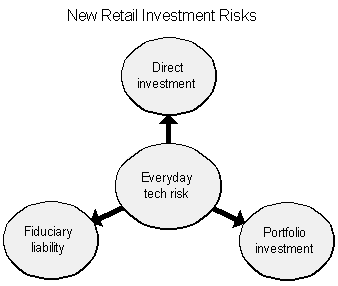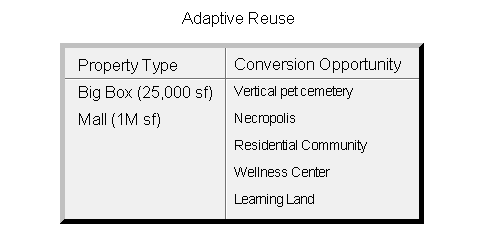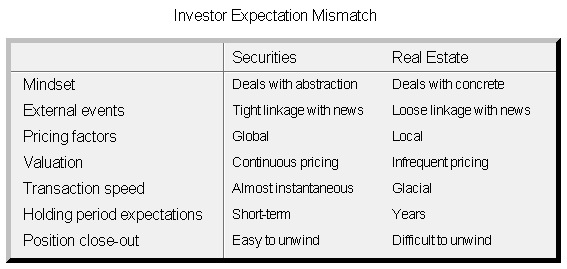FEBRUARY 1999 Millennium Madness
Table of Contents I. Online buying disintermediates retail space. A. What are the issues? 1. Is online buying a competitive sales channel? B. What are the assumptions? 1. Merchandisers first and site selectors second. C. Change metaphors to understand shifting space demand. II. Is online buying a competitive sales channel? A. The mainstreaming of the Web. 1. A New Sense of Place. D. Women online. 1. Students. F. Credit Card Security. 1. Market size. a. Greeting cards are emblematic. 3. Embracing a new shopping habit. III. The store in a wired world. A. Where are stores going? 1. The Bankers' response. a. Examine the merchandise mix. 3. Location analysis in a wired world. a. Online buying cannibalizes sales. D. Bundle Buying. IV. Sales channel reformation in a wired world. A. Charting a strategic course. 1. Ernst &Young's Retail Real Estate Survey. B. Strategic planning imperative. 1. Battle management software. C. Creating a Wired Leasesm. 1. Entry Strategy. a. Use. 3. Exit Strategy. a. Kick-Out/Early Termination. 4. Rent's Role. V. Everyday tech's property investment implications. A. A new dimension of risk. 1. Is Egghead a harbinger? C. Retail property investment strategies for a wired world. 1. A new risk arises. a. Direct investor and developer risk. 1. Corporations. a. The end of location hegemony. b. Portfolio investment risks. 1. The unexpected consequences of securitizing c. Fiduciary liability. VI. What business are we in? Additional articles
Millennium Madness Mark Borsuk* "We still marvel that most of our retail respondents can dismiss the Internet threat, suggesting that it will destroy catalog retailers but have limited impact on the mall. If ever there was a classic paradigm shift, Internet retailing is it." Emerging Trends in Real Estate 1999 1 I. Online buying disintermediates retail space. In the United States a social and economic phenomenon is starting to influence where people buy their daily necessities and many of their durable goods. Often called online shopping, it is more about online buying since this will influence retail space demand. Online shopping should be thought of as browsing and comparing but not necessarily transacting. Online buying is transacting. Online buying is of concern to developers, property owners, retailers and lenders since it has the power to disintermediate the value of location, the bedrock of value. Disintermediation occurs when merchants and customers can directly transact without the benefit of a store. Thus, the threat of online buying is to the store and not necessarily to the tenant. This paper examines the possible secondary consequences of everyday tech on retail real estate over the next few years. Everyday tech is the integration of computer hardware, software, networks and telecommunications in our daily routine. The paper argues online buying has taken off. Retailers who sell name brands, restocking items and commodity goods are most effected. Merchants will respond to transactions in cyberspace by changing their store leasing and ownership strategies. In turn, property owners and developers must create different offensive and defensive strategies to prepare for the shift away from location based retailing. The observations contained herein concern peculiar attitudes, expectations, and buying habits prevalent in the United States. Many non-technological barriers exist in other countries to hinder online buying. This is especially true in those cultures where face-to-face contact is important, where there are fewer national brands, and where retailers shun discounting. Nevertheless, Canadian investors, developers and lenders should pay special attention to online buying's impact since this new shopping habit will spill across the border in some fashion, creating new risks and opportunities. A. What are the issues? 1. Is online buying a competitive sales channel? In determining the viability of the online sales channel it is necessary to know what works online and the likely growth of the market. 2. How will retailers respond to the new sales channel? Online buying will cannibalize in-store sales. This requires merchants to reform the sales channel matrix of stores, catalogs and online to take advantage of cyberspace. Retailers will move to implement the concepts underlying the Wired Leasesm to gain locational flexibility and to shed stranded assets. 3. What are the retail property investment strategies for a wired world? The risk of online buying's specific impact on property will be established by the type of retailer. Developers, property owners, investors and lenders will need to create new screening techniques for evaluating tenants. In certain instances reusing the property for other purposes will be lucrative. In addition, direct investment risks will be different from portfolio investment risk. However, fiduciaries are likely to face increased scrutiny and potential liability for their decisions. B. What are the assumptions? If online shopping has a second order of impact on retailer behavior and space demand, then what are the assumptions? There are four. 1. Merchandisers first and site selectors second. Deng Xiao Ping, the late party boss of China, said "...it doesn't matter if a cat is black or white, so long as it catches mice." 2 In the context of retailing, his aphorism points to the primacy of merchandising over location. Few well located stores can succeed without first class merchandising. 2. Everyday tech influences space demand. Is it possible everyday tech could reduce demand for physical space? Yes, movie theaters are a case in point. They went into rapid decline from 1948 to 1963. The Chart below depicts a 50 percent drop in theaters over fifteen years while the number of TV households rocketed from less than 1 percent to 90 percent. The tremendous popularity of TV, an example of information technology, had a devastating impact on movie theaters. Source: US Census of Business, US Census of Service Industry. SIC Code
7832. While everyday tech partially explains the rapid decline in theaters, the population was also shifting to the suburbs. This was an important factor. However, everyday tech has the parallel affect on shopping as did the earlier suburban migration. Everyday tech deracinates place from activity by removing the shopper from the shop, another form of migration. 3. Marginal sales analysis explains channel shift. Examining aggregate sales misleads those who seek to determine the impact of the online sales channel. Online sales compared to total store sales are infinitesimal. Even over the next several years they will only reach a small percentage. However, the aggregate trend obscures their concentration in a limited number of retail categories. In those categories, online buying will have a disproportionate impact on store profitability. The adverse impact results from small declines in sales having a large impact on store profitability. 4. Everyday tech creates a non-geocentric buying habit. Customers are gravitating online for convenience, choice, and control. Many shoppers find it convenient to shop outside of normal store hours. Online sites can offer customers a wider selection of goods with their virtual shelf-space. They may also offer comparison shopping opportunities and useful third party reviews. Well-designed Web sites put the customer in control of the shopping process. They no longer have to suffer from uninformed or non-existent staff in the store. Online buying takes the shop out of shopping. The rapid diffusion of information technology, customer expectations about using the
technology, and the inherent advantages of online buying are coalescing to force a sales
channel transformation. The sine qua non for the sales channel
transformation is flexible leasing strategy. C. Change metaphors to understand shifting space demand. The rise of the online sales channel requires a reformation of the sales channel matrix. In addition to the store and paper catalog, retailers will add cyberspace. However, recognizing there is change does not necessarily change the geocentric mindset. Using new metaphors assists in the transition. Metaphors allow one to understand and experience using a visual image. Developers, property owners, retailers and lenders need to understand cyberspace is the antithesis of real space: it is an abstraction where no there exists. Using a real estate metaphor like electronic storefront creates confusion. The image of the store bears no relationship to the void of cyberspace. Rather, it limits one's ability to see the expanded possibilities of online buying from the customer's perspective. Thus, place metaphors imprison thinking by conjuring real estate images to analyze an incorporeal phenomenon. The Table below suggests some metaphors helpful in explaining retailing in a wired world. Is enthusiasm for the online world sufficient to create a market large enough to
sustain retailing? Even if the public embraces the medium, will women, the primary
shoppers, come online to buy? Is so, when? II. Is online buying a competitive sales channel? A. The mainstreaming of the Web. The Internet's rapid diffusion is startling. The total number of online users continues to grow quickly. Besides a rapid overall growth, women are reaching gender parity, older Americans are flocking online, credit card security concerns are fading, and online buying is becoming commonplace. B. Who is online? The June '98 Nielsen Media Research/CommerceNet survey found there were 79 million Internet users sixteen and over in the US and Canada. The user base grew by 36 percent from the September 1997 survey. In 1995, the first survey found 18 million people online. 3 This represents a 339 percent increase in four years. Among age groups, 50 percent of 16-34 olds are online! Surprisingly 48 million had gone online to browse or gather product information. This represented a 37 percent increase over September '97. Finally, actual buyers doubled to 20 million from the earlier period. The survey noted from September 1997 through June 1998, the growth of online buyers accelerated to 8 percent a month. 4 In comparison to 1996 online buyers, those who actually purchased, increased twenty fold. 5 The US data is equal to about 90 percent of each category. See Table below.
Additional online buyer demographics for the US discloses the following.
C. Buyer conversion lag. There is a strong correlation between time spent online and buying online. The longer online the greater propensity to purchase. However, the time between getting wired and buying things is steadily decreasing. James McQuivey of Forrester Research forecasts the time lag to drop to six months from one to two years. If so, this portends a horde of new buyers coming to market in the later half of 1999 and early 2000. Another factor holding back a more rapid diffusion of online buying is the tepid growth of PC households. In January approximately 45 percent of US households owned a PC. Those with annual incomes above $75,000 had a 70% diffusion rate while households with incomes below $30,000 had only a 25 percent diffusion rate. 6 However, the ongoing fall in prices is bringing PCs to the lower income households. Those households earning less than $35,000 annually are expected to be the leading source of first time buyers in 1999. 7 Furthermore, the lack of familiarity with computers at work is no longer a barrier to purchase. Fully 70 percent of these first time buyers do not use a computer at work. In addition, many of the new users are expected to get online. One overlooked trend boding well for retailers is the increase in moderately educated households coming online. The expanding PC user base spurred by falling prices, concern over educational opportunities for children and fear of being left behind are motivating lower income households to get wired. Approximately 50 percent of the heads of AOL user households have a high school education or less. 8 This is a tremendous pool of potential online buyers. 1. A New Sense of Place. The continuing rise of Internet households impacts work routines, learning and shopping habits. Everyday tech expands the home's role as an activity center. 9 Studying, shopping and working in the home took place before everyday tech. But, everyday tech introduces a quantitative and qualitative difference. 10 First, the Internet promotes a broader range of activities from home. Second, the quality of what can be accomplished continues to increase. Finally, wired families can buy back time, a precious commodity, by spending less time coming and going. In the case of education, the home can take on the role of public library and a skill building center for improving math, reading and writing. All on-demand and self-paced. In the case of shopping, the home becomes a show room for many items, a comparison shopping center and convenience store. In the case of work, the home becomes a venue for undertaking complex tasks in an island of tranquillity but still affords the opportunity to maintain contact with colleagues. The side benefits to home owners are fewer trips and less time spent driving. In short, the home's role is undergoing a basic shift in lock step with society's changing expectations about using information technology. The prime beneficiaries are women. D. Women online. The question no longer is whether women will achieve gender parity online but when they will become the majority of shoppers. The Nielsen Media Research/CommerceNet Study found women represented 43 percent of online users 11 and AOL reports women represent 52 percent of subscribers. 12 Another respected analyst finds women to be 45 percent of the online population, 39 percent of the buyers, and 46 percent of the shoppers. 13 In early 1995 they had only accounted for 10 percent of the online population. 14 For the Internet to become a robust shopping medium, women must be able to fulfill most of their regular needs online. In response shopping sites are refocusing to cater to women. In addition, there are a galaxy of sites for little girls, 15 teenagers,16 working women,17 pregnant women, 18 parents, 19 and everything in between to inform, entertain and offer advice. In some cases women now equal men buying online. 20 However, men tend to spend twice as much as women. 21 In other cases they are the majority of shoppers. See Table below. For example, women buy 75 percent of Peapod's groceries, they buy 69 percent of the Internet Florist's flowers, 50 percent of travel services from Preview Travel, and 43 percent of Amazon.com's books. 22 The growing importance of the home as activity center reinforces the trend of women getting online and using the medium to their advantage, including shopping.
E. Students and Seniors--Groups to watch. 1. Students. The Internet is an integral part of college life. An April survey of 100 campuses nationwide found 95 percent of undergraduates used the Internet. It is becoming part of their daily life. 23 Another survey found 44 percent of the classes using email. 24 Younger students are also heavily involved with the Web. Simmons TeenAge Research believes two-thirds of 12-19 year olds have gone online. 25 This strongly suggests students are acquiring new habits about communicating and studying online. Once started online it becomes very easy to move your work and shopping there. 2. Seniors. Those 55 and older represent about 4.3 million online users. 26 While numerically small they represent the fastest growing group of PC buyers, and WEB TV notes 30 percent of its users are over 60. 27 In addition, older Americans are online longer than any other age group. 28 Finally, seniors are online buyers. They have a higher propensity than other age groups to purchase books and business equipment and to invest.29 F. Credit Card Security.
G. Online buying trends. The degree online buying cannibalizes in-store sales partially reflects the number of customers going online, the degree the online channel meets the needs of shoppers, and whether the subtle preference shift for online purchasing continues to develop. Despite the rapidly accumulating evidence, many retailers and property owners still believe online shopping is nothing more than another catalog scare. Catalogs have had no negative impact on store based retailing. However, there is a fundamental difference between online shopping and catalogs. Buyers receive greater value from shopping online than by flipping through a catalog. See Table below.
Online shopping is another example of Metcalfe's Law of networks. 36 It states the value of a network increases
exponentially as the size of the network grows arithmetically. For example, when the
Fax was gaining popularity only a small annual increase in units was necessary to double
the value to users. Amazon.com offers an example of Metcalfe's law. The
bookseller provides customers with the opportunity to author their own book reviews and
alerts readers to books of interest by email. In contrast, the catalog is
static and can not provide enhanced value to customers. This is the critical element
distinguishing catalog shopping from online buying. 1. Market size. The Nielsen/CommerceNet study shows about a third (79m / 230m) of the North American
population sixteen and over online. The user base should grow to 50 percent over the
next several years. The study also disclosed online buyers, those who actually
purchase, are about a quarter (20m / 79m) of the Internet population. 37 If the online population reaches 50 percent,
then there will be 115 million people online. Assuming the same 25 percent ratio,
then there would be almost thirty million online buyers (50% X 230m X 25% = 28.75m).
As noted, women are expected to become the majority of shoppers over the next several
years. The prospect of fifteen million women online should compel many large
retailers to offer ever more appealing and user-friendly shopping sites for females. 2. Parallel developments accelerate online buying. a. Greeting cards are emblematic. The impact of the online channel on in-store sales may be glimpsed in the greeting card business.38 Those familiar with Blue Mountain Arts [www.bluemountainarts.com] know how easy it is to send a customized birthday, holiday or friendship card electronically. Even better, many cards are free. Customizing paper cards in the store can be done but it is much easier to create and send them online. This is the dilemma for the card companies. Do they try to capture the online market by offering a better mix of free and pay-for-view cards while seeking to retain their shrinking store based clientele or do they concede cyberspace to the upstarts like Blue Mountain Arts and protect their base? Paradoxically, the demand for e-cards is likely to explode as the number of email users hits 135 million in 2001.39 It also may weaken the habit of going to the card store to make the selection and reduce overall foot traffic in malls and centers. While the greeting card scenario is a distinct possibility, the paper based
encyclopedia is a victim of everyday tech. The Encyclopaedia Britannica has gone
from being sold door-to-door to a CD or online subscription service. Even the value
of this proprietary information will decline as ever more powerful search engines evolve
and library archives come online. b. Bill Presentment is the Killer App. Another example is bill presentment. Bill presentment offers people the ability to electronically pay their bills. For almost everyone this is the "killer application" 40 ; no more paper or searching for stamps. Bill presentment is a god send for procrastinators. It could spread quickly once bank-biller interoperability standards coalesce. By one estimate only 200 billers account for 70 percent of all US bills.41 The current estimate for bill presentment is 12 percent of all bills paid in the year 2000.42 Bill presentment, like the implementation of the SET security protocol, increases the
usefulness of doing routine tasks online. On the other hand, online stock trading
has already proven its usefulness to investors. During the January-June period 22
percent of retail trades were conducted online and they may reach 30 percent by December.43 c. Shopping Bots make life easier. Comparison shopping software robots ("Bots") are the next big thing for online buyers. These software agents visit retailer sites looking for a specific item and then report back on the basis of price or other search criteria. Some retailers block them hoping to avoid pure price competition, while other merchants try using them creatively. In the case of books, doing a search in Acses [www.acses.com] provides a ranking of online sellers by price along with shipping cost information.44 Bots benefit customers tremendously and add pricing pressure on mass retailers. Conversely, Books.com [www.books.com], one of Cendant Corporation's online stores, allow customers to comparison shop while at the site. If the Books.com price is higher, then the in-house Bot can adjust to the competitor's price. 45 This acts to retain the sale but at a lower profit. Using Bots offensively makes sense for mass merchandisers with high brand equity. Bots are in their formative stages. They are controversial since they reduce almost all consumer decisions to one based on pure price.46 In addition, searches are still too much of a "hit & miss" proposition, many only scan a predetermined subset of sellers or are blocked by uncooperative merchants. 47 Nevertheless, Bots are seen by the search engines as offering a major competitive advantage for driving customer traffic48 and for taking the bookseller Amazon.com to the next level of online retailing.49 Bots are of interest for two other reasons. First, branded goods and services are priced nationally and constantly compared. This eliminates regional pricing discrepancies and makes the Bots a new form of price competition. Second, to the extent the retailers seek to match the lowest price online, they may create a discrepancy between in-store and online pricing. This gives an incentive for in-store customers to arbitrage thereby reducing their in-store purchases in favor of shopping online. In addition, some may mistake the Bot induced pricing battle as a form of price discrimination against off-line customers. 50 Future legislation could mandate an online price check at the time of sale to maintain consistency between the online and physical worlds. The cumulative impact of Grandma receiving her birthday card via WEBTV, Mom paying her bills online, and Sis comparison shopping for a stereo on the Internet all reinforce the coming life-style change. One major beneficiary is online buying. 3. Embracing a new shopping habit. American consumers are starting to develop a new shopping habit. While still in the early stages of growth, the trend favors cyberspace for displacing or downsizing stores for a number of retailers, i.e., software [www.egghead.com]. This year 30 percent of online users are purchasing online and it will increase to almost 40 percent in 2000.51 The present generation of shoppers is learning to avoid the store in favor of online buying. This is similar to their parents and grandparents adjusting to self-service shopping. Many people intuitively agree with the nascent research showing a change in attitude. There is nothing novel anymore with buying books, casual clothes, groceries, toys, office supplies, CDs, and cars online. The lack of merchandise and other barriers to full scale merchandising are quickly falling away. 4. Watch the Supermarkets. Those merchants continuing to wait for the online market to mature before establishing a presence should follow events in the grocery business. An industry consortium, Consumer Direct Cooperative (CDC), led by Andersen Consulting estimates that over the next ten years 15 percent of US households will purchase groceries online and the biggest share of sales migrating online will be for the weekly stock-up trip. 52 Oddly, the one area where online grocery shopping would seem to be at a disadvantage, picking fresh produce, is a winner. 53 Peapod [www.peapod.com] and Streamline [www.streamline.com] are pioneering the consumer-direct revolution. If they succeed, it negates the value of a convenient location. 54 This has ominous implications for non-food mass retailers and real estate. If customers are gravitating online to buy their groceries, including produce along with most of their other daily needs, and pay their bills, then their geocentric shopping attitude significantly changes about where to shop. There will be a strong incentive to go online to comparison shop, obtain advice and purchase. This invisible paradigm shift will affect retailers. A growing audience is supporting online shopping. However, any impact on real estate is unlikely unless the retailers change their emphasis on location based merchandising. What are the forces compelling the retailers to radically alter their sales channel matrix? III. The store in a wired world. A. Where are stores going? The role of the store is about to undergo a profound change. Many off-line
retailers will experience intense price and market share competition from traditional
competitors who offer the third sales channel, stealth competitors who only exist online,
trusted intermediaries providing bundle buying services and manufacturers seeking to
exploit channel conflict. Some fortunate retailers will have either goods or
customers unlikely to migrate online. However, if off-line retailers fail to
incorporate the online sales channel they may very well find themselves in a competitive
free fire zone unable to protect their in-stores sales. B. A future history of online buying. Underlying trends should galvanize retailers into incorporating cyberspace's impact on their business and customers into their strategic thinking. The Table below suggests the kind of trigger events likely to occur over the next three years. This is the short-term in real estate time. If these events materialize, it will confirm the pace and strength of online buying. The key events to monitor are the inexorable increase in wired households and customer expectations about shopping online. If this possible future happens, then existing store leasing strategies are clearly out of sync with retailing in a wired world. A Future History of Online Buying 1998 -30 million households online 1999 -35 million households online 2000 -40 million households online
C. How will migrating sales impact store location decisions? There is a strong parallel between banks and mass merchandisers in leveraging the value of the online channel. In the past they have sought to grow assets and sales by opening more branches and stores. Cyberspace allows them to reach customers with less physical infrastructure. See Table. Parallel Futures
1. The Bankers' response. The threat to banks from not getting online is to lose many of their most profitable customers while continuing to maintain an expensive branch network. An estimated 22 percent of households are expected to be banking online by the end of 2001. 55 In response banks are taking the offensive by going online to retain and nurture these customers. 56 They are also seeking to entice customers online by offering bill presentment. 57 In some cases branches are moving into supermarkets to better serve their customers. They must also eliminate costly branches and personnel. 58 2. The Retailers' response. Many of the same dilemmas face retailers when much of their goods and customers can easily move to cyberspace. Off-line retailers now have to confront existing and unknown competitors while maintaining stores, a high cost sales channel, and even when they go online be pressured by autonomous Bots constantly reporting on their prices. 13 In order to develop a survival strategy, retailers need to perform an INFOTECH SCANsm. An INFOTECH SCANsm asks three interrelated questions. First, what portion of the merchandise can migrate online? Second, what portion of the customers are likely to buy online? Third, how profitable is the customer segment going online? See Diagram below. INFOTECH SCANsm
a. Examine the merchandise mix. Today, what goods and services can be sold online? See Table below. If the merchandise mix consists of name brands like Kleenex, Heinz ketchup, Pilot pens, and HP laser printers or trusted retailer brands, then customers can easily buy or comparison shop online. A subsidiary question asks how much extra value does the retailer add to the transaction from the customer's perspective?
The more the transaction resembles a "park, pick and purchase" exercise with little human involvement, then the more incentive to buy online. This level of commodity shopping negates the value of location. b. Examine the customer's technographics. How willing is the customer to migrate online? How many customers are already wired? What percentage of the local customer base is likely to become wired over the next several years? Should the mass merchandisers offer incentives to customers for going online? 59 Today, 27 percent of US households are online. By the year 2000, more than 35 percent are likely to be online. 60 As previously noted, wired consumers increasingly expect to shop online. 61
c. Does Pareto's Rule apply? Who are the most profitable group of customers for the mass retailer? What if that group migrates online? Will the online customers confirm Pareto's 80/20 rule? One example from the online world illustrates the point. Virtual Vineyards [www.virtualvineyard.com] found 10 percent of their "core visitor" customers purchased 80 percent of their wine. 62 The best situation for an off-line retailer is to know most of their profitable customers will not migrate to cyberspace. Conversely, the greater the correlation between the most profitable customers and the pertinent demographics, psychographics and technographics, the greater the risk sales will migrate online. 3. Location analysis in a wired world. How can retailers make location decisions about new stores, adding stores in existing markets, and increasing store size without considering the prevalence of wired customers and online buying? Whether using the gravity model for convenience stores or the analog model for specialty stores, all site selection methodologies rely in some manner on a rear view mirror analysis, i.e., the correlation between distance and the propensity to patronize a particular location. This is a spatial model. Cyberspace upsets the assumed decision trade-off by the customer. The online sales channel fundamentally alters the predictive value of existing location decision algorithms. Retailers face the distinct possibility of falling into a site selection sinkhole by employing analysis not incorporating the likelihood of online buying. They must ask their site selection staff and location software vendors to explain how migrating sales will impact location decisions. Presently, the state of the art is behind the times. 63 4. Buying activity in cyberspace. Once a determination is made on the types of merchandise likely to be sold online, the retailer needs to analyze the customers having the greatest propensity to buy online. Surveying store customers is one method. Another is to match the target customer's profile with the online population in the store's trade area. 5. The marginal sales analysis. The third sales channel would have very little impact on leasing strategy, if there were no effect on store economics. However, this is not the case. Online buying will have a profound impact on individual store financial performance by cannibalizing sales. a. Online buying cannibalizes sales. Retail analysts know it only takes a small change in store sales to have a dramatic impact on individual store profitability. 64 In 1997 at the ICSC Research Conference a presentation entitled Are New Store Sales New?: How The Department Stores Assess Sales Transfer And Incremental Sales Gains discussed the loss of sales either from new competition (sales diversion) or by adding another store in the trade area (sales transfer). Sales transfer is the polite term for cannibalization. One analysis of cannibalization suggested that a mere seven percent shift in store sales could drive down profitability by almost fifty percent. A sluggish decline in variable costs in the face of falling sales is one explanation for the dramatic change in profitability. Unlike catalog shopping that did not impact stores, online shopping is analogous to building a sister store nearby. It transfers a portion of in-store sales from the old store to cyberspace as if it were a new store. 65 Already, this is the subject of academic inquiry. 66 Estimating the potential impact on store performance from migrating sales will require knowing the customer's propensity to shop online, the relative profitability of the customer segment, and the degree store sales could increase from other sources. b. An expanding pie? Many believe online buying will have a limited impact on store profitability so long as
store sales expand. This is known as the expanding pie argument, the assumption
being that the ratio between online sales and in-store sales remains constant for each new
sales dollar. If the ratio were to remain constant, then the presumed negative
impact of migrating sales would be held in check. However, the argument implicitly
assumes new sales will come from consumers shopping in the same old way. That is,
incremental sales are asymptotic in nature, continuing to flow in the same
proportion. See Chart below. Such an assumption is very dangerous to make in
the face of a rapidly expanding wired population. One need only recall the rise of
self-service shopping to realize how quickly habits change. Thus, whether online
sales directly cannibalize in-store sales or store sales grow at a slower rate than
expected, the new sales channel can dramatically impact store performance.
c. EC MentorTM shows the way. The credit card companies and the banks recognize the potential benefits of online shopping. They are encouraging greater online transactions by lowering fees to members, promoting SET and making the benefits of the online channel known to merchants. MasterCard's EC MentorTM is an example of promoting electronic commerce's benefits. 67 EC Mentor' is an Excel spreadsheet template developed by Easton Consulting of Stamford, Connecticut 68 for merchants to use in evaluating the net benefit of online sales. It measures the cost to establish the new sales channel versus the added revenue and cost savings associated with online sales. The financial model also seeks to quantify the second order impacts of customer buying habits changing as a result of migrating their purchases online. The implicit message of EC MentorTM is fixed expenses like rent will decline after the introduction of an online sales channel. Retailers are facing the prospect of having their in-store sales stagnate, their best customers migrate online and their stores' financial performance suffer. It will be true whether they capture the migrating purchase in cyberspace or not. The inherent benefits of online buying coupled with the credit card institutions' incentives to move business online are going to exert a negative force on the store. How should retailers bring their store leasing strategy into sync with a wired world? D. Bundle Buying. The stealth competitor Amazon.com demonstrated how quickly an online specialty retailer could develop a large customer base, threaten off-line competitors and achieve market recognition. This is the initial shock online buying brings to retailers. A second shock awaits with the advent of bundle buying. Bundle buying is the "next big thing" 69 and should appear within two years. Bundle buying describes a trusted party' online offering of a wide variety of goods and services in an intuitive and easily shopped format. See Table below. The trusted party offerings would reflect those from the best supermarket, super drug store and warehouse club. They would be the most popular items at the lowest price including delivery. The trusted party or intermediary could be a known mass merchandiser, a joint venture under the banner of a nationally known firm, a well known financial institution partnering with a recognized category leader, or perhaps Microsoft. Cendant Corporation's NetMarket [www.netmarket.com] is the archetype. Customers can purchase groceries, health and beauty items, pet supplies and consumer electronics.
Achieving a critical mass of customers likely requires making the order size small enough for restocking of everyday items while encouraging customers to expand their purchases. Taking orders as low as fifteen dollars would be a great convenience for singles and the elderly. Bundle buying could devastate community shopping centers anchored by supermarkets and drugstores as sales migrated online. The potential combination of lower prices, wide selection, convenient delivery, minimum order size and ancillary services should give off-line retailers pause in continuing to pursue present leasing and construction plans. Retailers faced with the need to leverage the online sales channel must reconsider the value of stores. They need to reexamine their future expansion plans, the number of stores within a trade area and store size. Reforming the sales channel matrix requires a fundamentally different leasing strategy offering greater flexibility. What will be the impact on space demand and property owners? A. Charting a strategic course. Unless senior management gives a clear mandate to actively pursue the online sales
channel, there will be little impact on space demand. Only when management believes the
new channel can lead to increased profits or significantly reduce expenses will there be a
change in leasing and store acquisition strategy. Current retailer strategy is contrary to
sales channel reformation. 1. Ernst &Young's Retail Real Estate Survey. The results of the Second Ernst & Young Retail Real Estate Survey substantiate the findings of the earlier survey: planning cycles are considerably shorter than lease terms. 70 See Table below. Planning cycles averaged four years versus a thirteen year average lease commitment. Although, the authors noted smaller retailers were moving towards planning in harmony with shorter lease terms, no trend was yet evident. The second annual survey again highlights the fact real estate leasing is not a fundamental concern of strategic planning. Online shopping, while acknowledged, was not considered a substantial threat to store operations, with income, population and age being the most important site selection criteria.
B. Strategic planning imperative. The opportunities of the third sales channel require retailers to evaluate their costs
and benefits against the return from stores and paper catalogs. Hybrid metrics are
necessary to capture performance for the new retail business model. The use of battle
management software will assist the transformation. 1. Battle management software. The introduction of the cyberchannel as a competitor to the store suggests tracking sales and costs in a way to quickly adjust sales channel performance. Instead of waiting years to get out of a lease or remodel a store, performance measurements should signal when to emphasis one channel over another. See Diagram below.
One important indicator of the shift to online buying would be tracking the location of online shoppers and compare their delivery zip code with the closest store to determine the extent of sales migration. The program should seek to discover opportunities from merchandising in each channel or combination of channels by use of financial metrics to uncover what works online versus what works in the store and/or the catalog. Another feature should be to aid leasing strategy based on sales migration patterns. C. Creating a Wired Leasesm. The goal of a Wired Leasesm is to provide the retailer with sufficient flexibility at an affordable cost to reconfigure the sales channel matrix as the online channel grows. Failure to obtain shorter lease terms and early termination rights over the next two to four years carries the risk of having greater difficulty in modifying or terminating store leases as investment opportunities expand online. Already, there are hints in the trade press of online shopping causing retailers to put surplus space on the market.71 In addition, questions about online sales are beginning to enter some of the sessions at the annual ICSC Law Conference. The Wired Leasesm is a retail lease but with a very different purpose. The primacy of the location is no longer assumed The online channel adds a new dimension to the mass merchandiser's calculation by fundamentally altering the value of the store. Therefore, space leases must incorporate the concept of migrating sales and lesser demand for space. Many provisions of the traditional retail lease take on new strategic meaning. Early termination rights, the length of the initial term and option periods, and percentage rent rise to a higher level of importance in a wired world. D. Wired Leasesm objectives. Conceptually there are three interrelated sections in a Wired Leasesm . The first concerns entry strategy. The second section deals with operating strategy. The third part relates to exit strategy. The Diagram below illustrates the interrelated provisions.
1. Entry Strategy. The major issue for entry strategy is to minimize the initial term. The strategic decision to open the online sales channel explicitly requires determining what portion of sales will come from cyberspace, the store and catalog. This guides the initial term decision. If customers are likely to remain geocentric, then the initial term may be lengthened. Conversely, if a rapid migration is envisioned, then a shorter initial term is necessary. If options are sought, then determining the length of each option period and number of options becomes a function of estimating the portion of the customer base likely to remain store shoppers. Seeking a short-term lease impacts build-out expenses and fixture costs. Who absorbs them and over what time period? Perhaps the real question to ask is "How does online shopping change the store's format, build-out requirements, and fixture needs?" 2. Operating Strategy. The major issues in operating strategy analysis are use, percentage rent, co-tenancy, and contraction/expansion/relocation rights. a. Use. Merchandising philosophy is at the heart of the use clause. In a wired world an attempt to limit merchandise mix is counter productive. The mass merchandiser should be expecting to reinvent itself because of online shopping and competitive challenges. It is very disadvantageous to commit to a merchandise mix via the use clause. The Wired Leasesm requires a very expansive use clause. b. Percentage Rent. The tenant's obligation to pay percent rent takes on several new facets for mass retailers going online. The issues are the cybercafe "gotcha," what percent to apply if the tenant's primary merchandise mix changes, and the associated issues of exclusive use and radius clauses. Cybercafes are becoming popular in malls. 72 Patrons can go online while having a snack. But what happens if the patron makes a purchase online in the Cybercafe from a mall tenant's Web site? Is the retailer obligated to pay percentage rent? Will landlords begin including a cyber-radius clause for recouping off-site sales back into the mass merchandiser's percentage rent obligations? An expansive use clause undermines the value to a mass retailer of the exclusive right to sell specific merchandise in a center. A mass merchandiser's overall strategic goal will balance these inconsistent positions. If there is a flexible use provision, will changes in merchandise mix over a certain threshold trigger a new percentage rate to apply? Will it apply across the board or along categories? How will the rate be set? c. Co-tenancy. Cyberspace may significantly diminish the value of co-tenancy. What happens when the co-tenant in the mall significantly reduces store size, changes use or alters merchandise mix? d. Expansion/contraction/relocation rights. The Wired Leasesm requires mass retailers to be able to contract, expand, and relocate a store within the project. The lack of flexibility in the face of changing customer buying habits hinders the goal of aligning store size with shopping patterns in a wired world. The retailer needs to view this provision as a cost item and expect landlords to bargain aggressively. 3. Exit Strategy. The essence of a Wired Leasesm is to shorten the lease commitment. This can be done in a number of ways by use of a kick-out right, right to go dark, a Put and a flexible assignment/sublet provision. Each tactic carries a cost to compensate the landlord for the increased risk of uncertain cash flow. It is likely all of these provisions require modification and need to be used in conjunction with other lease clauses to achieve the retailer's goal. a. Kick-Out/Early Termination. Generally, a kick-out provision terminates the lease early based on under performing sales. If sales fall below a predetermined level within a specific period, then one party may terminate the lease. It can be a unilateral or mutual right. The Ernst & Young survey noted retailers consider this a key provision. 73 The ongoing impact of online shopping on in-store sales requires the provision to continue through the original term and option periods. Also, should the sales target change over time due to the retailer's shifting space needs? A proxy of sales per square foot could be used to establish the level. If the property owner contributes to space improvements or fixture costs, how will a portion of the cost be recaptured? Will leasing commissions be paid in arrears? What other actual and opportunity costs will the landlord seek to claim? b. Go Dark. A variation on the "Kick Out" is the "Go Dark" provision allowing the retailer to discontinue operations although still requiring the tenant to pay rent and perform other lease obligations. If the tenant is obligated to pay percentage rent, then the continuous operations clause may frustrate the ability to terminate operations.74 c. Put. Alternatively, the retailer could obtain the right to "Put" the space back to the landlord. Could the tenant give a portion back? Pricing this right, over what time period, and having it apply to options will be the subject of hard bargaining. d. Assignment/Sublet. The Wired Leasesm requires a flexible assignment or sublet right. Will the retailer have the right to assign the lease? Will the tenant receive a novation from the landlord? Can the space be partially sublet? Can the tenant have concessionaires? If the tenant has concessionaires, is there a maximum amount of space they may occupy? Does the use provision significantly restrict a potential assignee or subtenant? Finally, how will mass retailers deal with a potential subtenant seeking to negotiate a Wired Leasesm? 4. Rent's Role. It is counter-intuitive for most real estate practitioners to consider rent as a residual issue since almost all discussions about space start with asking "How much?" However, the question assumes there is no direct competitor to location. The online sales channel negates the assumption. Instead, location is becoming more commodity like and will have to start competing with cyberspace for the channel investment. The question the retailer must ask is: "What is the cost of buying flexibility for changing the sales channel matrix?" Will the cost be expressed in terms of fixed rent with periodic increases and decreases? Will rent be a percentage of the tenant's gross store sales and adjusted periodically? Or will the rent be a lower fixed amount traded for a higher percentage rent? 75 It will be a challenge to quantify the cost for lease flexibility. Further, those who seek to create the Wired Leasesm will have to devote considerable time in educating property owners and lenders. However, the failure to pursue greater flexibility in lease termination rights will narrow the retailer's flexibility during a period of great upheaval. 5. Case Study - Consumer Electronics Consumer electronics retailers are ripe to get "amazoned." That is, they risk forfeiting business to Internet competitors. 76 Consumer electronics retailers add little value to the transaction, customers find it difficult to compare features among brands, and service is minimal to non-existent. In effect what have been their strengths, i.e., wide selection, convenient locations and low prices become their weaknesses in cyberspace. In 1997 the big three, Circuit City (www.circuitcity.com), Best Buy (www.bestbuy.com) and CompUSA (www.compusa.com), controlled about 35 percent of the $64 billion market through 969 stores. 77
Online the big three's brand equity has diminished value. Stealth, non-traditional and traditional competitors can offer online Bot certified lowest everyday pricing, comparison shopping engines, exhaustive third-party product reviews and direct shipping to the home without sales tax of dishwashers, clothes dryers, TVs, compact disk players, and current model computers. Offering these services is attractive to "gadget freaks"78 and price conscience buyers alike. The product comparison aspect of consumer electronics shopping bears special mention. Manufacturers offer a bewildering number of products slightly differentiated by style or features. In most instances the differences are unimportant. However, the resulting customer confusion inures to the benefit of the retailers as in the mattress business. 79 The emergence of a trusted comparison shopping agent significantly undermines the obsfucation ploy and leads to increased price competition. The online sales channel forces Circuit City and Best Buy to create a fully transactional site in order to remain competitive. While CompUSA already offers its stock online, it will not be immune from online buying's impact. All three retailers must reevaluate their location based strategy. In this new retailing environment, does an aggressive store roll-out program offer the highest return? Or does leveraging the online sales channel, reducing store commitments and creating showrooms produce a higher return? In either case, incorporating the strategy of the Wired Leasesm becomes mandatory. Retailers and property developers can no long apply the old rules. Online buying is going to profoundly impact those merchants selling brand names, commodity items and self-service goods. The momentum is building for traditional retailers to establish themselves online. In doing so they will call into question their location based merchandising strategy and the need for continued store expansion. Wall Street and the lenders will also follow their progress and punish them accordingly for poor execution. The recent federal three year moratorium on states charging sales tax on Internet transactions only strengthens the online channel's influence on retailing strategies. How will developers, property owners and lenders deal with the ensuing risks and opportunities? V. Everyday tech's property investment implications. "Just as most malls are caught in a seventies time warp of growing suburbs and homemaker moms with time to shop, owners want to believe that the Internet's impact on consumers will be limited. "That'll replace catalogs," says a retailers, echoing a common refrain. Please--just wake up! The Internet will change the way people shop and transform current retailing formats in ways that the industry has trouble imagining." Emerging Trends in Real Estate 1999, p. 40.
A. A new dimension of risk. Everyday tech severs place from activity, thereby creating a new risk dimension. In other words, work no longer needs a workplace, learning no long needs a school and shopping no longer needs a shop. Property investors, developers, lenders and fiduciaries must now consider how information technology changes the attractiveness for their space. However, geocentric thinking and the human predisposition to deny change conspire to blind-side otherwise intelligent people into ignoring everyday tech's disintermediary force. The consequences are to reduce location premium and to shift significant bargaining power to tenants. The Diagram below depicts the process.
B. Online buying's impact on retail property value. Everyday tech's ability to take the shop out of shopping will force retailers to reform their sales channel matrix. They must develop and leverage the online sales channel while redeploying their assets in the physical world. The result will be a limitation on new store growth, reduction in the number of stores within an existing trade area, and converting stores to showrooms. The secondary consequence of the retailer's need to reform the sales channel is to lessen the value of many locations by reducing the rent they are willing to pay. The Diagram below depicts the process.
Egghead's move to become a pure online retailer by abandoning physical locations is the end of history for post-WWII retailing. First, there was the need to secure convenient locations. Then size mattered, creating demand for Superstores, Big Boxes and Mega-malls. Now, everyday tech brings shopping home by offering ultra-convenience, virtual shelf-space and quick comparable pricing. While Egghead may not do any better online than in-line, its ongoing operation is part of the evolving new sales channel. 80 If Egghead succeeds, then retailers will find many attributes of their location-based strategy compromised. They will no longer find convenient location, competitive pricing, and vast inventory reliable predictors for future store success. 2. Wall Street loves online buying. TIME magazine's July 20 cover screaming "KISS YOUR MALL GOODBYE Online shopping is faster, cheaper and better" captured the public's excitement over online shopping. It culminates Wall Street's two year love affair with Internet firms and shopping stocks in particular. Witness Amazon.com's value. On November 17 the stock was worth $7 bn as compared to Barnes & Noble and Border's combined value of $3.9 bn. Although, some analysts challenge the Amazon.com model 81, the stock market's extraordinary valuation of this storeless bookstore relates to the market's perception of a fundamental change in retailing ahead.82 Publicly traded retailers slow to embrace the new sales channel risk incurring the ire of stock analysts and market commentators. 83 Those particularly susceptible to the growing online competition may find their stores derisively referred to as a "stranded asset"84 and the stock price punished. Others outside the equity market may begin expressing concern when a retailer fails to understand the online channel's long-term consequences. Lenders are one such group. Another group is credit rating agencies. Recently, Fitch IBCA expressed concern over the credit quality implications for traditional retailers of online buying and the failure to adapt.85 Those retailers providing employees with stock options also need to be concerned with negative market sentiment. This will add subtle pressure on management to implement the new sales channel. Wall Street's embrace of the online sales channel and Egghead's radical departure for cyberspace point to a very different type of retailer emerging over the next several years. C. Retail property investment strategies for a wired world. 1. A new risk arises. Online buying creates new risks for direct investors, portfolio investors and fiduciaries. Direct investors, whether developers or owners, have to seek tenants less susceptible to online buying's siren song or undertake adaptive reuse of the space. Portfolio investors in real estate securities have trading market volatility to consider along with the opportunities of taking short positions. Finally, fiduciaries who do not consider everyday tech's impact on retail property investments may incur liability for breaching their duties. See Diagram below.
a. Direct investors and developer risk. It should come as no surprise to retail property developers and owners that everyday tech impacts demand for retail space. Unlike retailers where the geocentric nature of shopping was dogma, corporations and financial institutions have aggressively moved over the last decade to reduce space and increase the intensity of use. The decision reflected the need to increase shareholder value and align corporate strategy with real estate use. The advent of online buying forces retailers to confront similar issues. It directly puts developers and investors at risk. See Table below.
1. Corporations. The movement to re-engineer and downsize organizations to increase shareholder value has drawn attention to their real estate holdings. Leased and owned space is now an asset for advancing the firm's strategic goals and no longer a fixed cost of doing business. This represents a radical change in thinking. The emphasis on increasing shareholder value has had a profound impact on the role of
real estate in organizations. Over the last decade, manufacturing and service firms
aligned space demand with corporate strategic goals. Cost reduction and rationalization
followed. Firms directly linked real estate to the business plan and developed financial
metrics for evaluating how space influences return on investment. Corporations needed to
analyze real estate's contribution to the firm's strategic goals. This recognition grew
from the efforts of academics, industry groups, and management consultants to correctly
price and manage occupancy costs. 86 The
results are favorable, and one large office user reported slashing occupancy costs by
fifty percent. 87 The senior management
understood they could do with less space, that space costs had to align with corporate
investment goals, and that all real estate decisions had to further shareholder value. 88 2. Financial Institutions. The banks and other financial institutions are going through the same space reduction process to achieve increased profitability made possible by technology. Traditional branch banking is being evaluated along with online banking and smaller units operating in supermarkets and other convenience locations. Many bank branches are redundant. In total they occupy more space, 250 million square feet, than general merchandise department stores. 89 One analyst predicts, "Half of today's 60,000 branches will likely be gone by the end of the decade." 90 In addition, branch transaction costs cannot compare with online banking. According to Wells Fargo Bank the cost of doing a transaction over the Internet is $0.01 while the same transaction at a branch costs $1.07. 91 Household online banking is rapidly increasing. In 1996, 2.5 million households (3.1 %) banked online. By 2002, the number could reach 18 million (18.6%). 92 These are very compelling reasons for bankers to rethink their business model of branch banking to reduce real estate and overhead costs. 3. Retailers. The ability to shift transactions into cyberspace thereby reducing the cost of the physical sales channel is a lucrative option for retailers. The metrics developed by the academics, consultants, and firms to align space needs with corporate strategy are well known. When retailers begin to focus on restructuring their store commitments, they will look to this pioneering work. a. The end of location hegemony. In fact, retailing is already in the academicians' sights. On October 22, 1998, the Financial Times of London carried an interview with Professor Gary Hamel (p.9) where he called for a radical change in retailing based on the growth of online commerce. Hamel observed each significant change in retailing created new leaders and those who led could not meet the challenge of the next shift. He also stated the current retailing leaders will struggle to adapt to the Internet ways of doing business. Professor Hamel is best known for his work on developing revolutionary competitive strategies. His analysis examines three issues. First, a company must explicate the orthodoxies and dogmas defining its business. Second, the firm must define and understand its core strengths. Third, it must seek out discontinuities in the environment and turn them into a competitive advantage.93 Restructuring the retail value chain away from the store fits his schema to develop revolutionary strategy. The prevailing dogma is location based retailing, the core competency for success is merchandising, and the rise of the online sales channel provides the discontinuity necessary to leap-frog the competition. In an odd juxtaposition of views, the prior day's edition carried an interview with Mr.
David Glass, the Chairman of Wal-Mart. Mr. Glass believes electronic retailing would never
account for more than a small percentage of sales because "Shopping is a social
experience for many people in the world."94
His comments are interesting for several reasons. First, Wal-Mart sells the kinds of goods likely to be found online. Second, it may only take a small shift in sales to make a Wal-Mart store unprofitable. Third, what is experiential about pushing a shopping cart through a 100,000 sq. ft. building to restock cereal, toilet paper, soap and buy name brands when they are available online? Will market leaders like Wal-Mart succumb to the new competition in a wired world? Professor Hamel's ideas portend retailers viewing some of their stores as stranded assets and this would have a direct impact on property values. b. Cybersurgeons - The rise of a new warrior class. There is an additional reason for retailers and property owners to be mindful of everyday tech's impact. A new class of corporate raiders is about to arise: Cybersurgeons. They will meld the techniques developed over the last decade in the corporate and financial service sectors into their valuation models to leverage the third sales channel. Retailers and corporations alike with large holdings of space amenable to downsizing
will become their prey. In future corporate battles, Cybersurgeons will substitute
software for staff to reduce headcount, impose telework programs on employees to cut back
on space needs, sell corporate holdings, and renegotiate leases. In the coming retail
takeover battles, they will aggressively deploy the online sales channel by creating
strong incentives to move customers online, reduce sales staff and the number and size of
stores. Cybersurgery will force property owners and lenders to become unwilling
participants in a new round of retail consolidation while Wall Street cheers them on. c. Creating new value by adaptive reuse. What are the options for big boxes, power centers and malls when tenants downsize or vacate? Adaptive reuse of the property is one solution. Several examples illustrate new uses for space. See Table below. Big boxes could be transformed into vertical pet cemeteries. Cubic feet should be worth more than square feet! In the case of a regional mall possible new uses include a one-stop interment and final resting place (the Necropolis), a theme residential development (Paris in the 1920s) with part of the parking lot converted into a park, an assisted living and convalescent complex (Health World), and a continuing education and training facility (Learning Land). The idea of converting a mall into a Necropolis is not so far fetched. Cemetery space is running out. 95 One enterprising developer in North Vancouver, B.C. is building a five story high-rise for the dead in a residential neighborhood.96
Conversely, forward thinking communities would offer incentives to developers in the form of expedited planning and zoning approvals and property tax reductions. The national debate over treating Internet sales like catalog transactions exposed how heavily local and state governments relied on sales tax revenue.98 The negative consequences of land use planning developed around retailing are going to manifest themselves in the years ahead as a result of online buying. b. Portfolio investment risks. Investors seeking to diversify their risk by purchasing real property securities also face a new risk dimension. The rapid securitization of US real estate creates many new investment opportunities and traps for the unwary. The growth of real estate investment trusts (REITs) since 1990 has been phenomenal. REIT market value went from $8.7 billion in 1990 to $140 billion in October 1998. 99 The widely held property equity and debt now are subject to trading market risk. Traditional real estate investors could have a hard time adjusting to change. They are unaccustomed to price volatility unrelated to tenant availability, new construction and the ability of buyers to finance their purchases. The trading market environment is alien to their mindset. See Table below.
1. The unexpected consequences of securitizing retail property. The securitization of retail real estate dramatically links trading and investment markets. The direct linkage removes the slack that existed to absorb regional, national and international shocks. Formerly, the private, long-term nature of the landlord-tenant relationship separated them for market gyrations. The trend to aggregate properties into securities subjects them to the systemic fragility of trading markets. But while many trading markets are global, giving them greater depth, they also display a greater tendency for normal accidents. Normal accidents come in many forms and occur randomly. A riot in Indonesia, a war in Iraq or a Russian financial collapse all have the capacity to destabilize share prices regardless of whether the event directly impacts the underlying asset. How is it possible for retail REITs to be detached from the vicissitudes of rapid technological change and chaotic events? Securitizing retail property also creates short selling opportunities. This was not
possible with private property but now is done online. Finally, securitizing property
creates a new group of overseers who are unrelated to the risk of ownership. REIT equity
analysts, credit rating agencies, the SEC and public relations firms are now all part of
the value equation. Their opinions drive market expectations. The following parable illustrates the clash of expectations about retail property values. On Friday, December 31, 1999, the Nine Dragon Gumi announced the purchase of We-B-Cheap, the nation's largest computer retailer. The 150 store chain had been the darling of Wall Street for several years until in-store sales began falling precipitously in 1998. The big box superstore format, averaging 25,000 sq. ft., so successful earlier in the decade, was faltering. Paradoxically, We-B-Cheap's overall sales continued to climb as a result of strong online buying. A chorus of top retail stock analysts called for a radical restructuring of We-B-Cheap's sales channel matrix. Like other mass market retailers, We-B-Cheap had to contend with product price deflation induced by rapid technology change and the high fixed cost of operating stores as the primary sales channel. On Monday, January 3, 2000, We-B-Cheap, under new ownership, announced the settlement of the recently filed shareholders' suit. The company promised a massive restructuring. One month later it filed for bankruptcy. The debtor's plan called for rejecting leases on one hundred stores and downsizing the remainder into 5,000 sq. ft. showrooms sans inventory. The Big Box REIT was one casualty of the bankruptcy. We-B-Cheap properties represented 30 percent of the portfolio. Launched in 1993, Big Box found the recipe for success by offering public ownership of retail stores with high-technology tenants. Pension funds and other institutional investors were the majority owners of its thinly traded shares. The bankruptcy filing set off a chain reaction and Big Box's stock plummeted. Market insiders shorted the stock quickly, sinking it below the net asset value. Market wisdom held REITs were a good defensive stock, less inclined to decline in value if the overall market went south but unlikely to match gains in an up market. Unfortunately, the underlying theory was untested in the securitized world of property ownership that became so popular in the 1990s. The double whammy of information technology altering retail space demand and REIT shares falling below their presumed net asset value came as a horrible shock to investors. The "beta burn" forced them to make a hasty exit. Another repercussion of the bankruptcy was to freeze the issuance of new debt and equity for retail REITs, starving them for capital. Flush with offshore cash, the Gumi became Big Box's largest shareholder and took
control from the badly shaken management. On January 29, Big Box announced the soon to be
vacant We-B-Cheap stores would become vertical pet cemeteries. Under the slogan "You
Love'm, We Keep'm" the REIT could achieve profitability offering cubic space instead
of square footage. Market historians recorded this as the first successful cybersurgery. c. Fiduciary liability. Investment fiduciaries face potential liability for failing to consider the new risk of everyday tech's impact on retail space demand and property values. The Emerging Trends in Real Estate 1999 analysis converted the issue from being merely speculative to one of contemporary concern. This has serious implications for those who invest on behalf of others. Depending on the jurisdiction, fiduciaries may find the new risk imputed in their duty to act prudently. Fiduciaries are on notice to investigate retail tenants and properties with greater care. They must inquire about the retailer's susceptibility to online buying, the likelihood of a negative impact from online competitors, future space needs, the property's adaptive reuse potential, and whether the new risk is imputed into the price. While there is a strong tendency to believe "that what is, ought to be" by assuming geocentric shopping habits are immutable, institutional and individual fiduciaries should now add cyberspace questions to their investment review checklist. VI. What business are we in? The emergence of the online sales channel is a discontinuous innovation. Instead of anticipating trends based on generally accepted expectations, retailers must now contend with change where the rules are unknown. This positive crisis gives rise to new winners and losers. The winners will be those who can adapt their merchandising online and leverage their store's name recognition into cyberspace. Those traditional retailers who survive will still do a majority of their business from stores but the store will become a part of the sales channel, not its exclusive focus. Developers, owners, investors and lenders must anticipate and plan for the coming store crisis brought about by tenant demands for a Wired Leasesm , Wall Street's love affair with online buying, and changing customer attitudes. These all represent profitable opportunities. Those with foresight will seek to develop projects less dependent on tenants likely to be impacted by cyberspace. Others will accept the challenge of the Wired Leasesm and create new retailing environments. Some will seek out adaptive reuse possibilities. Those who exploit strength through weakness will become the new real estate winners in the next Millennium. (11-17-98)
* Mark Borsuk (mborsuk@ix.netcom.com) is Managing Director of The Real Estate Transformation Group, a firm analyzing information technology's impact on space demand and providing strategies for property owners, developers, retailers and lenders. In addition to consulting, Mark is a retail leasing broker and real property attorney practicing in San Francisco. Mark's focus is on store leasing strategy in a wired world. Some have called him a "fringe visionary" for pointing out this embryonic issue. In his view, high tech is becoming everyday tech for many families. Everyday tech will shift a portion of their buying online thereby changing fundamental geocentric shopping patterns. In other words, online buying will take the shop out of shopping. Mark has written extensively on how the daily use of computer hardware, software, networks and telecommunications transforms attitudes about work, learning and shopping. He has published articles in Discount Store News, Pensions & Investments, The Journal of Applied Real Estate Analysis, Real Estate Review, and Urban Land. Much of his analysis is on the Internet. Mark has addressed online buying's impact on space demand before the Stanford Real Estate Round Table, the ICSC, the Urban Land Institute, the National Retail Federation, the International Mass Retail Association and institutional investors. Prior to entering real estate, Mark was a foreign exchange trader and currency advisor in New York and Tokyo. Speaking and reading Japanese, he pioneered in the analysis of the Yen and the Japanese money markets. His articles appeared in many financial publications including Euromoney and the Asian Wall Street Journal. Mark holds an MBA from Sophia University (Tokyo), a Japanese language certificate from Nichibei Kaiwa Gakuin (Tokyo), and a JD from Loyola University (Los Angles) where he was a member of the Law Review. He is a native Californian and retail property owner.
Total WAR: Online buying's assault on the store, October 1998 A New Sense of Place: INFOTECH's impact on the Home, September 1998 From Full House to Empty House: What Does Movie Theater History Have to Do with Retail Space Demand?, International Council of Shopping Centers Research Quarterly (Summer 1998). The Mad Mohel: Will Cybersurgeons Clip RetailREITs?, May 1998 On-line Shopping's Impact On The Retail Store, Shopping Center Business, Retail Leasing Strategy for a Wired World, Journal of Applied Real Property Web sites cast big shadow over real estate leasing strategy, Discount Store
News, Third Wave Chutzpah: retailer leasing strategy for a wired world. Cybermalling-A Retail Death Sentence?, Journal of Property Management, Third Wave Wipeout: Do retailers need landlords in a wired world? The Challenge of Information Technology to Retail Property, Urban Land, Will On-line Shopping Impact Retail Leasing? Technology complicates real estate investing, Pensions & Investments,
January 20, THIRD WAVE TSORIS: Do Real Estate Investment Fiduciaries and Appraisers Have THIRD WAVE WIPEOUT: INFOTECH's Impact on Retail Space Demand. Third Wave Wipeout: Commercial Property Investment in the Information Age., Is Commercial Real Estate Investing Still Profitable in the Information Age?,
What Is the Impact of INFOTECH On Commercial Real Estate?, SIOR Don't be a Cyberputz, California Real Estate Journal, March, 1996. Real Estate Tax Policy for the Information Age, Real Estate Review,
NOTE: All amounts expressed in US dollars. 1 Emerging Trends in Real Estate 1999,
PricewaterhouseCoopers & Lend Lease, p. 7. News Releases | Articles | Upcoming Talks | Memorable Quotes Copyright ©1995 - 2020. Mark Borsuk. All rights reserved. Disclaimer notice |


